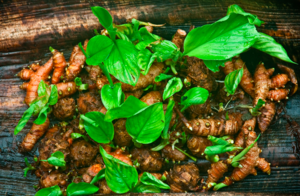
Turmeric (Curcuma longa) is a plant within the ginger family (Zingiberaceae family).[1] While most often used in powdered form to colour curries, it can also be used fresh and has a subtle ginger flavour.
Growing turmeric in a household[edit | edit source]
This is an excellent container plant, and keeping it in a container makes it easier to bring indoors when the weather gets cooler (for those in cooler climates).[1] It should never be subjected to frost. Shallow containers are ideal as the root does not grow long.
If you want to grow it in the ground, this can be done in a variety of gardening zones (zones 7b through 11 (USA)), and the roots can be gently dug up in winter and stored in a cool place, then replanted the next warm season start.[2]
The rhizomes can be purchased fresh from market or store sellers, or can be ordered online. Just be sure that if you're using ones being sold for culinary use, that they're very fresh. Select large roots which have little to no shrivelling.[1]
Prepare the rhizomes by leaving them to sprout over a few weeks. Place them in a warm and dry place out of direct sun. While this step is optional, it helps prevent the roots from rotting when grown.[1]
Plant the rhizomes in a container in late spring to early summer. The container should have good quality soil and compost. Place the rhizome in with the shoot side facing upwards. Water in gently. If planting in the ground, plant when the danger of frost has passed.[2]
Keep in a semi-shaded yet very warm spot, keeping up the warmth as much as possible. Bring indoors when the weather gets colder. Water regularly while growing. Add liquid fertiliser every two weeks.[1] If grown in full sun, the soil needs to be kept constantly moist.[2]
The rhizomes can take up to 10 months to grow fully.
Expect the plant to go dormant during the winter season. Do not water the plant when it is dormant.
Growing turmeric on a large scale[edit | edit source]
This section needs to be provided.
Problems[edit | edit source]
If you spot the leaves hanging limp and with burnt tips, the plant is getting too much sun, too little water or is experiencing drought.[2]
Uses for turmeric[edit | edit source]
Fresh turmeric can be added grated to salads, added to vinegar and vinaigrette, used in stir-fries, curries and dahl dishes.
Turmeric has anti-inflammatory properties.[1]
The leaves can be used to wrap food for steaming. However, this should not be done when you're growing a single or just a few plants, as removal of leaves prevents the plant from flourishing. This is more for those growing large amounts of turmeric. The same goes for eating the shoots––only suitable for those growing large quantities.
See also[edit | edit source]
- Turmeric (Practical Action Brief) - this page discusses the processing of turmeric